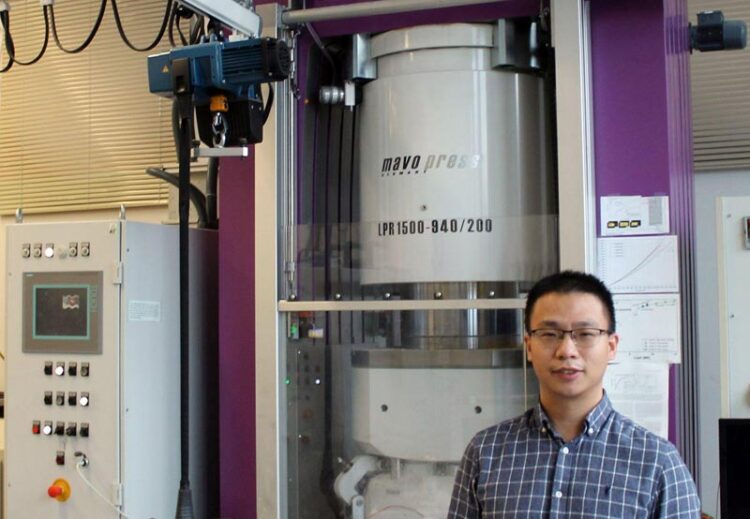New glass with supreme toughness

Dr. Hu Tang, first author of the study, in front of a high-pressure press at the Bavarian Research Institute of Experimental Geochemistry and Geophysics (BGI).
Photo: UBT / Chr. Wißler
Researchers at the University of Bayreuth, together with partners in China and the USA, have produced an oxide glass with unprecedented toughness. Under high pressures and temperatures, they succeeded in paracrystallizing an aluminosilicate glass: The resulting crystal-like structures cause the glass to withstand very high stresses and are retained under ambient conditions. Paracrystallization thus proves to be a promising process for producing extremely break-resistant glasses. In “Nature Materials”, the researchers present their findings, in which the German Electron Synchrotron (DESY) in Hamburg also participated.
In many respects, glass is an attractive material for modern technologies. However, its brittleness, which easily leads to cracks and fractures, limits its potential applications. Research approaches to highly increase the toughness of glass while retaining its advantageous properties have largely failed to produce the desired results. The new approach presented in “Nature Materials” starts with oxide glasses which have a rather disordered internal structure and are the most widely commercially utilized glass materials. Using aluminosilicate, which contains silicon, aluminum, boron and oxygen, as an example, the research team in Germany and China has now succeeded in giving it a new structure. To this end, they employed high-pressure and high-temperature technologies at the Bavarian Research Institute of Experimental Geochemistry and Geophysics (BGI) of the University of Bayreuth.
Simulated structure of glassy (left) and paracrystalline (right) grossular. The atoms of the elements oxygen, silicon, aluminum and calcium (from small to large) are coloured lighter the higher the degree of order in the surrounding structure. Image: Hu Tang
At pressures between 10 and 15 gigapascals and a temperature of around 1,000 degrees Celsius, the silicon, aluminum, boron and oxygen atoms grouped together to form crystal-like structures. These structures are called “paracrystalline” because they differ significantly from a completely irregular structure, but they do not approach the clear regular structure of crystals. Both empirical analyses using spectroscopic techniques and theoretical calculations clearly showed this intermediate state between crystal structures and amorphous irregularity. Even after a drop in pressure and temperature to normal ambient conditions, the paracrystalline structures in the aluminosilicate glass remain. The penetration of the glass with these structures results in the toughness of the glass being many times higher than before paracrystallization. It now reaches a value of up to 1,99 ± 0,06 MPa (m)¹/². This is a toughness never before measured for oxide glasses. At the same time, the transparency of the glass is not seriously affected by the paracrystalline structures.
The researchers explain the extraordinary strengthening of the glass by the fact that forces acting on the glass from outside, which would normally lead to breakage or internal cracks, are now primarily directed against the paracrystalline structures. They dissolve areas of these structures and transform them back into an amorphous, random state. In this way, the glass as a whole acquires greater internal plasticity, so that it does not break or crack when it is exposed to these or even to stronger forces.
“Our discovery highlights an effective strategy for developing highly damage-tolerant glass materials, which we plan to pursue with our research in the coming years,” said Dr. Hu Tang, first author of the new study. “The increase in toughness due to paracrystallization shows that structural changes at the atomic level can have a significant impact on the properties of oxide glasses. At this level, there is great potential for optimizing glass as a material that is far from being exhausted,” adds Prof. Dr. Tomoo Katsura of the Bavarian Research Institute of Experimental Geochemistry and Geophysics.
Wissenschaftliche Ansprechpartner:
Prof. Dr. Tomoo Katsura
Chair of Structure and Dynamics of Earth Material
Bavarian Research Institute of Experimental Geochemistry and Geophysics (BGI)
University of Bayreuth
Phone: +49 (0)921 / 55-3791
E-mail: tomo.katsura@uni-bayreuth.de
Originalpublikation:
Hu Tang et al.: Toughening oxide glasses through paracrystallization. Nature Materials (2023), DOI: https://doi.org/10.1038/s41563-023-01625-x
https://www.uni-bayreuth.de/press-releases/glass-supreme-toughness
Media Contact
All latest news from the category: Materials Sciences
Materials management deals with the research, development, manufacturing and processing of raw and industrial materials. Key aspects here are biological and medical issues, which play an increasingly important role in this field.
innovations-report offers in-depth articles related to the development and application of materials and the structure and properties of new materials.
Newest articles

Innovative 3D printed scaffolds offer new hope for bone healing
Researchers at the Institute for Bioengineering of Catalonia have developed novel 3D printed PLA-CaP scaffolds that promote blood vessel formation, ensuring better healing and regeneration of bone tissue. Bone is…

The surprising role of gut infection in Alzheimer’s disease
ASU- and Banner Alzheimer’s Institute-led study implicates link between a common virus and the disease, which travels from the gut to the brain and may be a target for antiviral…

Molecular gardening: New enzymes discovered for protein modification pruning
How deubiquitinases USP53 and USP54 cleave long polyubiquitin chains and how the former is linked to liver disease in children. Deubiquitinases (DUBs) are enzymes used by cells to trim protein…



